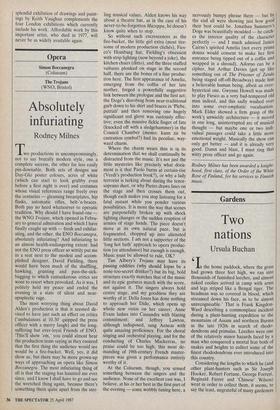Exhibitions
Pencilled out
Giles Auty
Edinburgh in springtime is like Edin- burgh in summer: just as autumnal but with fewer Japanese visitors. Granted a pleasant climate, Edinburgh would be- come the most agreeable of cities; as it is, it remains merely one of the most beautiful and hospitable.
While most artistic activities reach a crescendo during the city's annual festival, there is now no shortage of excellent gallery exhibitions at all times of year. One of the more original of these is that showing currently at the Gallery of Mod- em Art in Belford Road. This exhibition tours later to Aberdeen, Glasgow and St Andrews and I wonder what the worthy inhabitants of each will make of it. The title, for a start, is badly chosen and mystifying. A prize should be offered for the best stab at its meaning. It refers, I found, to the new breed of artist whose reaction to landscape is too complex and arcane to find expression via anything as obvious or `reactionary' as brush or pencil.
Learning about this recalled for me an experience from my unlamented days as a part-time lecturer in an art school. Know- ing the emphasis my usual colleagues and I placed on old-fashioned skills, a further part-time lecturer, of African origin, was called in by the college authorities to `liven up' our students. The first project he set them was a large composition, with the curious complication of using a knife and fork as drawing implements. After some hours of this difficult practice one of the students inquired — impolitely some may think — if their new tutor was in the habit of eating his food with pencils.
Novel methods are of value where they lead to genuine personal discoveries. Where they do not, they lead, instead, to a kind of fey silliness. Visitors will find plenty of examples of this, as well as poetic invention, in this productive exhibition. Juxtaposed balls cleverly formed from deer scats and bones, pine cones and dead pine wood (Tine bones') say something elo- quent and oddly moving about nature's cycles. This is a work by Chris Drury. Andy Goldsworthy, too, made clever use of natural materials, exposing us to other- wise undiscovered aspects of their beauty. It was the grand old men of conceptual art whose work I found, not for the first time, the most irritating. To me, nearly all artefacts from Richard Long and David Tremlett present a simultaneous smugness and banality which must nevertheless be invisible to their worldwide host of admir- ers. Ian Hamilton Finlay, by contrast, is a genuine poet of the simple. I intend nothing but praise in describing his work `Revolution' as a clever conceit. While not using either the demo& brush or pencil, Thomas Joshua Cooper and Raymond Moore have produced striking images via the camera lens. More of their rich work and less arid minimalism would have made this a more rewarding exhibition.
On leaving it I found myself immediately confronted by 'Soldiers resting in a field', a wonderful landscape painting by' Edward Burra, in that part of the gallery devoted to recent acquisitions. This work will remind visitors, if reminder were needed, that in the right hands there is nothing inexpress- ive or lacking in the products of brush and pencil when applied to landscape — or anything else.
At the Scottish Gallery (94 George Street, Edinburgh) Hugh Buchanan's watercolours display all their customary elegance and panache. These small works have a kind of high baroque splendour but the artist, unfortunately, seems unable to produce anything in a humbler key to provide a necessary contrast. However, he could hardly do better than slip upstairs to make close inspection of the woodcuts and paintings of Charles Hodge Mackie (1862- 1920), a little-known but considerable tal- ent. Mackie's coloured woodcuts are among the finest I have ever seen and rank with the best productions of his more famous French contemporaries, such as Bonnard. It is surprising that such excellent and historically interesting works can still be found outside public collections.
In conclusion, it is pleasant to report that Richard Demarco's ambitious new gallery in Blackfriars Street is nearer completion than when I last saw it in August. Richard has been an original presence in Edinburgh for 20 years and the city would lose much without his idiosyncratic ventures. At Mer- cury Gallery (2/3 North Bank Street) a splendid exhibition of drawings and paint- ings by Keith Vaughan complements the four London exhibitions which currently include his work. Affordable work by this important artist, who died in 1977, will never be as widely available again.



































































 Previous page
Previous page